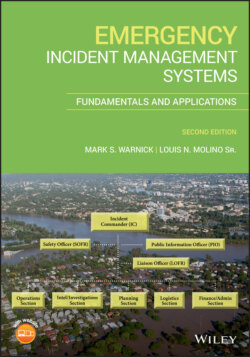Читать книгу Emergency Incident Management Systems - Mark Warnick S., Louis N. Molino Sr - Страница 60
2.5.5 Communications
ОглавлениеThrough looking at past disasters, we know that communications have always been an issue in any major or catastrophic incident. Unfortunately, communications will probably always be a weak link when managing an incident. While communication will likely be a problem for many years to come, those using IMS methods, such as ICS, should always strive to improve communications.
In a large or catastrophic incident, communications overload should be expected in most instances. In the planning stages for major incidents, state and local agencies have, and should continue to identify alternative methods for communicating. These communication mitigation measures would be best if they included methods to communicate locally and outside of the local area. It is also beneficial if communications can be established with nongovernmental agencies that may have limited knowledge about disaster communications.
In the Tokyo attack, communications between the responding agencies was essentially nonexistent. Interagency communications were fragmented at best, and in most cases, these communications were not even pursued. The various government agencies involved with the response did not cooperate or communicate with each other. According to reports from Pangi (2002), this ultimately continued throughout the duration of the incident. Each agency essentially operated within their own little bubble by failing to communicate effectively with other agencies.
While there was a breakdown in the communications equipment in the Tokyo incident, there is no mention in any of the resources about trying to mitigate this problem. One way that this could have been mitigated would have been sending someone with a radio to those hospitals to facilitate communications, or in sending runners to the hospital. In looking at the communications between EMS units and the hospitals, it was plain to see that the lack of communications was a contributing factor overwhelming the closest hospital, while most of the other hospitals had relatively few patients (Murakami, 2000).
Perhaps most disturbing part about communication in the Tokyo incident is that the hospitals that were treating patients did not learn from officials at the scene that this was a chemical attack. For three hours, St. Luke's Hospital sent researchers digging through the library trying to find answers. Additionally, doctors that did realize what was happening used the only communications method they could think of to contact hospitals, a fax machine. The confirmation that local hospitals needed did not come from a government agency, it came from the local news (Murakami, 2000).
In Oklahoma City, it was expected that there would be issues with communications during the preparedness phase while when planning for larger incidents. Those issues were in the process of being addressed, but a full resolution of identified deficiencies had not been fully implemented. Even though some mitigation measures had been implemented, this bombing was of such magnitude that it went beyond what was expected. It is likely that even if all proposed implementation measures were enacted, communications would still have been challenging (Manzi et al. 2002).
The After‐Action Report ([AAR] n.d.) from the Oklahoma City bombing found multiple communications problems that occurred from the onset. The first communications failure in Oklahoma City that was identified were with the phones. All phones, both land lines and cell phones, had issues that were described as intermittent to inoperable. For the most part, cell phones were inoperable because of the vast number of individuals attempting to make phone calls immediately following the bombing. There was also some infrastructure damage that occurred to cell phones due to the explosion, but it was not severe. Land lines were inoperable because of damage to the infrastructure caused by the bombing (ODCEM, n.d.).
When first responders arrived in the area, the only communications they had were their radios. As was expected, those with critical information, or urgently needing assistance, were overwhelming the only available radio frequencies at that time. With the amount of people being trapped or injured, these channels were immediately overwhelmed with attempted communications, and it was nearly impossible to effectively communicate (ODCEM, n.d.).
In an interview with Fire Engineering (1995), the Oklahoma City Fire Chief described how radio traffic was so heavy that he had difficulties in trying to find a break in radio traffic to give the Incident Commander (IC) situation updates. He had urgent information on the extent of the damage and where structural failures may collapse on first responders. The Chief described that even when radio silence was needed so that rescuers could listen for potential victims, it was extremely difficult to achieve (Fire Engineering, 1995).
Compounding the communications problem after the bombing, most communications between ambulances and the hospitals suffered a failure in communications, much like what occurred in Tokyo. The difference was that the Oklahoma City bombing communications issues were mainly rooted in hospital error. Because the emergency frequency had not been used in quite some time, many of the hospitals had turned the volume down or turned their radio off. In order to mitigate this problem, police officers were sent to each hospital to tell them to turn on or turn up their radios. If needed, it was planned that police or other personnel who had radios would relay information to the hospital to mitigate communication issues (Nordberg, 2010).
There was also the communications issue of each discipline having their own individual frequency. This caused interoperability problems when trying to communicate between discipline, unless there was face‐to‐face communications. The state had issues communicating with the locals, and the locals had interoperability issues communicating with federal response agencies. Communications between certain disciplines was nearly impossible; however, the state was able to communicate with federal resources via radio. Much of this was overcome by having face‐to‐face communications with mobile command centers that were brought in, who would then relay the information. This proved that mobile command centers that are placed within walking distance of each other helps to at least partially mitigate communications issues.
